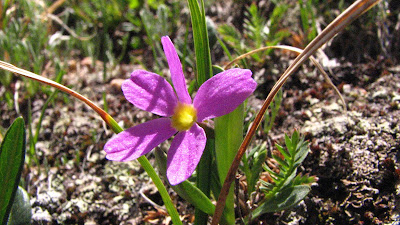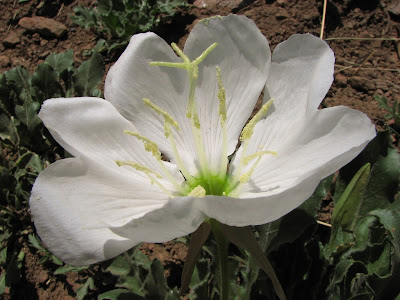The word "primrose" itself evolved from the Latin prima rosa, which simply means "first rose(1)." The genus name Primulus, which was the diminutive form of primus, simply means "first." Both etymologies refer to the tendency of some primroses to be an early-blooming flower in the spring, although this is not necessarily true for species here in Colorado.
Primulaceae, the "True" Primrose Family
The most familiar members of this family are probably the common garden primrose, Primula vulgaris, which sprouts overnight in garden centers in little plastic pots around Easter. Cyclamens also hail from this family. Members of Primulaceae tend to share certain characteristics: leaf attachment is either basal or opposite; flowers have five petals joined at the base, five sepals joined at the base, and five stamens opposite the petals; flowers frequently cluster above a bract. Some Primulaceae species that inhabit the Colorado Rocky Mountains include Parry's Primrose, Alpine Primrose, and Shooting Star.
Primula parryi, Parry's Primrose
P parryi growing in the forests on Loveland Pass at about 11,000 ft, just below
timberline. The fuchsia flowers strike a strong contrast with the surrounding woods.
Parry's primrose, named for the prolific plant collector Charles Parry who was active in Colorado during the late 1800s(3). A single stalk on each plant with matte textured flesh supports several brilliant pink flowers. The base of the plant is a rosette of fleshy, elliptic to lanceolate leaves. Parry's primrose blooms in the summer in wet habitats, although it can grow other places as well. Closer investigation of the flowers will yield a fetid odor, which the flower uses to attract pollinators.
Primula angustifolia, Fairy Primrose, Alpine Primrose
P. angustifolia growing just above timberline on Pike's Peak. This flower is tiny, growing no
more than a four inches tall.
P. angustifolia's family relationship with P. parryi is immediately apparent. Recent phylogenetic research suggests that the two species share a common, hybrid ancestor(5). I mistook this flower for a smaller version of Parry's primrose growing at high altitude. Larger, low-altitude flowers will often have dwarf incarnations in the alpine zone, but P. angustifolia is actually a distinct species. Tiny rosettes of lanceolate leaves yield one to several flowers that are colossal compared to the rosettes supporting them (see photo above). Like their lower altitude cousins, P. angustifolia blooms in summer and emits a rancorous odor which attracts pollinating flies.
Dodecatheon pulchellum, Shooting Star
D. pulchellum flowers growing near a stream on Pike's Peak.
Another angle. This flower has an unusual brilliantly red band where the petals join.
The shooting star is instantly recognizable and always a pleasing find. The distinctive, swept-back petals look like virtually no other flower in the region, making it easy to identify. As with the other primroses, D. pulchellum's flowers are supported by a single stalk rising from a basal rosette of lanceolate to elliptic fleshy leaves. The pointed purple projections on the front of the flower are united stamens, which require insects to force their probosces past the pollen-rich stamens to access the nectar(6). D. pulchellum may bloom in Spring or Summer, and seems to prefer wet habitats. Every time I have seen it has been by a stream or other body of water.
Onagraceae, the Evening Primroses
The most familiar evening primroses are again the garden varieties, such as the Missouri evening primrose and the Mexican evening primrose. Many evening primroses are perennial, although some are annuals. Plants in Onagraceae tend to have four petals, four stamens, and a stigma with as many lobes as there are carpals in the ovary (typically four, although may be two or five)(7). Locally, three species of interest include the tufted evening primrose, fireweed, and Hooker's evening primrose.
Oenothera caespitosa, Tufted Evening Primrose
C. caespitosa growing on an arid slope in the foothills near Denver. The blossoms
are enormous compared to the rest of the plant.
Another tufted evening primrose growing in lava rock scree on North Table Mountain.
This picture was taken around 4:00 pm as the flowers were just opening.
This gorgeous flower is easy to identify and provides a striking contrast to its dun-colored background. At a distance it could be mistaken for a prickly poppy, but closer inspection reveals much different foliage and a yellow center on the poppy which is absent from the tufted evening primrose. The 3-4 inch wide flowers sport four heart-shaped petals with a prominent stigma with four lobes(6). The petals are often white, although I have seen pink variations. The flower rises from basally attached, lanceolate leaves which may be dentate to deeply lobed. True to the name, tufted evening primroses bloom later in the day so that they can be pollinated by night-flying insects. The buds of the flowers have an almost pyramidal shape which is a good field mark when blossoms are not all the way out. Tufted evening primroses grow on dry, south-facing slopes during spring and summer.
Interestingly, C. caespitosa has been identified as a source of gallic acid, which may be useful in the treatment of some cancers(7). The research I have found is quite limited, indicating that this primrose is probably a far cry from a cancer cure, but it is interesting nonetheless.
Chamerion angustifolius, Fireweed
Fireweed growing on Mount Evans around 10,000 feet. Note the prominent stigma.
Fireweed is a gorgeous, summer-blooming flower that can turn entire alpine meadows pink. It is named not for its color, but for the fact that it is often one of the first plants to colonize burn scars(6). Flowers have four pink petals with a prominent four-lobed stigma. The claw-like curved pink structures between the petals are the sepals. Leaves are oppositely attached, lanceolate, and have prominent veins which tend to be lighter in coloration than the surrounding leaf. Unlike the tufted evening primrose, fireweed's flowers persist through all times of day. There is precious little literature on fireweed, which indicates that researchers don't like pretty flowers.
Oenothera elata, Hooker's Evening Primrose
Oenothera elata growing near a lake. Note the exaggerated hypanthium.
Hooker's evening primrose has a confused naming history, hence Hooker appearing in the common name but not the binomial name. Apparently one proposed name for the plant involved honoring Sir Joseph Dalton Hooker, the director of the Royal Botanic Gardens, who was in turn a fan of the work of Charles Parry (he of P. parryi!), whom he dubbed "King of Colorado Botany(9)." However, the species proved to be quite variable, and the Hooker name wound up attached to a subspecies out in California. Our own local variant is O. elata subspecies hirsutissima, likely in reference to the tiny hairs which are faintly visible in the photo above on the flower buds(10).
O. elata has flowers mounted on a long hypanthium. The petals are heart-shaped and yellow, with stamens and a stigma roughly equal in length. Leaves are lanceolate, oppositely attached, and feature a more lightly colored vein down the center. The plant overall has a shrubby appearance, with the one I have seen growing about 2.5 feet tall. The hypanthium is a useful field mark for differentiating O. elata from a highly similar local species, O. longissima. While O. elata has petals around the same length as the hypanthium, O. longissima has a hypanthium about three times the length of its petals, giving it a decidedly lanky appearance.
O. elata has been heavily researched, with many articles looking at genetics, viability for bioproduction of oils, and its relation to other Oenothera ssp. I can only speculate that this is because O. elata has been domesticated as a garden perennial, and that more work is done on plants which are more readily available.
Thank you for reading about primroses. I do not find them as intriguing for their novelty as lichens or poisonous plants, but sometimes it's nice to simply look at pretty flowers and learn their quirks.
References
- Harper, D. (n.d.) Primrose [entry in an online dictionary]. Retrieved from: http://www.etymonline.com/index.php?term=primrose
- Elpel, J. (n.d.) Patterns of the primrose family. Retrieved from: http://www.wildflowers-and-weeds.com/Plant_Families/Primulaceae.htm
- Schneider, A. (n.d.) Parry Primrose. Retrieved from: http://www.swcoloradowildflowers.com/Pink%20Enlarged%20Photo%20Pages/primula%20parryi.htm
- Primula angustifolia (n.d.). Retrieved from: http://www.easterncoloradowildflowers.com/Primula_angustifolia.htm
- Cianchi, R., Arduino, P., Mosco, M. C., & Bullini, L. (2015). Evidence of hybrid speciation in the North American primroses Primula suffrutescens, P. parryi, P. rusbyi and P. angustifolia (Primulaceae). Plant Biosystems, 149(2), 229-234.
- Mammoser, D., & Tekiela, S. (2007). Wildflowers of Colorado. Cambridge, Minnesota: Adventure Publications, Inc.
- Onagraceae (n.d.) Retrieved from: http://www.wildflowers-and-weeds.com/Plant_Families/Onagraceae.htm
- PETTIT G, R., SALDANA E, I., & LEHTO, E. (1974). ANTI NEOPLASTIC AGENTS PART 35 RHUS-TRILOBATA. Lloydia (Cincinnati),37(3), 539-540.
- Schnieder, A. (n.d.) Colorado flora of Charles Parry. Retrieved from: http://www.swcoloradowildflowers.com/Slide%20Shows/Charles%20Parry's%20Colorado%20Flora/index.htm
- Schnieder, A. (n.d.) Oenothera elata. Retrieved from:http://www.swcoloradowildflowers.com/Yellow%20Enlarged%20Photo%20Pages/oenothera%20elata.htm








No comments:
Post a Comment